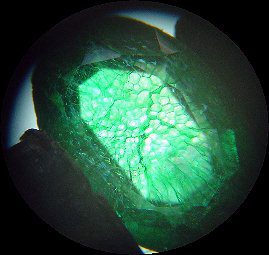Enhanced Gem Inclusions
Gem treatments can affect a stone’s value and stability. Learn how the most common procedures work and how to identify enhanced gem inclusions.
3 Minute Read
Related Articles
Gemstone Visual Examination Quizzes
A visual examination is the first step to identifying a gemstone. These quizzes will help student gemologists learn to recognize...
Read More
Gemstone Examination Lesson
Learning how to conduct a gemstone examination takes practice. Follow an expert gemologist step-by-step through tests of five unknown samples....
Read More
Specific Gravity Testing Part 5: Using Heavy Liquids
Using heavy liquids to measure a gemstone's specific gravity poses some health hazards. Learn the techniques and precautions that gemologists...
Read More
Gemstone Coatings: CVD and More
Gemstone coatings are a simple way to enhance color and luster. Learn about commonly coated gems, different coating techniques, and...
Read More
Latest Articles
800 Years of Mogok: A Celebration in Tenuous Times
As Mogok, Myanmar prepares to celebrate its 800th anniversary, the inhabitants of this prolific gem producing region face an uncertain...
Read More
What is the Average Gemstone Faceting Yield?
What’s the average gemstone faceting yield from a single piece of rough? Learn how to estimate how much material you’ll...
Read More
Pyroxmangite Value, Price, and Jewelry Information
Pyroxmangite grains are rare, seldom clean enough to facet, and difficult to cut. However, when cut, they are extremely beautiful...
Read More
How to Identify Emerald Simulants and Synthetics
Gemologists can separate natural emeralds from emerald simulants and synthetics. Learn about the most common tools and techniques for this....
Read More
Never Stop Learning
When you join the IGS community, you get trusted diamond & gemstone information when you need it.
Get Gemology Insights
Get started with the International Gem Society’s free guide to gemstone identification. Join our weekly newsletter & get a free copy of the Gem ID Checklist!
